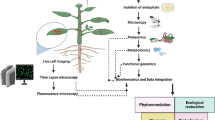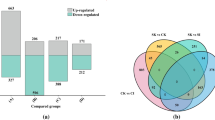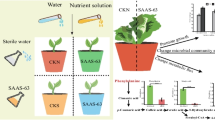Abstract
Knowledge of biological evolution and genetic mechanisms is gained by studying the adaptation of bacteria to survive in adverse environmental conditions. In this regard, transcriptomic profiling of a glyphosate-tolerant Enterobacter strain NRS-1 was studied under four different treatments to investigate the gene-regulatory system for glyphosate tolerance. A total of 83, 83, 60 and 74 genes were up-regulated and 108, 87, 178 and 117 genes down-regulated under 60-NPG, 110-NPG, NaCl (355 mM) and HCl (pH 4.46) stress treatments, respectively. Complex gene network was identified to be involved in regulating tolerance to glyphosate. This study revealed that NRS-1 has gained glyphosate tolerance at the cost of osmotic and acidic resistance. The 25 differentially expressed genes are reported to may have partly changed the function for providing resistance to glyphosate directly, among them genes metK, mtbK, fdnG and wzb that might detoxify/degrade the glyphosate. However, under 110-NPG condition, NRS-1 might have utilized economical and efficient ways by depressing its metabolism and activity to pass through this stress. Hence, the present study provides insights into the genes involved in glyphosate tolerance, which can be effectively utilized to engineer herbicide-resistant crop varieties after their proper validation to manage weed growth.






Similar content being viewed by others
References
Alonso Casajus N, Dauvillee D, Viale AM, Munoz FJ, Baroja Fernandez E, Moran Zorzano MY, Eydallin G, Ball S, Pozueta Romero J (2006) Glycogen phosphorylase, the product of the glgP gene, catalyzes glycogen breakdown by removing glucose units from the nonreducing ends in Escherichia coli. J Bacteriol 188:5266–5272
Altschul SF, Madden TL, Schaffer AA, Zhang JH, Zhang Z, Miller W, Lipman DJ (1997) Gapped BLAST and PSI-BLAST: a new generation of protein database search programs. Nucleic Acids Res 25:3389–3402
Anders S, Huber W (2010) Differential expression analysis for sequence count data. Genome Biol 11:R106
Andrés-Barrao C, Lafi FF, Alam I, De Zélicourt A, Eida AA, Bokhari A, Alzubaidy H, Bajic VB, Hirt H, Saad MM (2017) Complete genome sequence analysis of Enterobacter sp. SA187, a plant multi-stress tolerance promoting endophytic bacterium. Front Microbiol 8:2023
Arfarita N, Imai T, Kanno A, Yarimizu T, Sun XF, Wei J, Higuchi T, Akada R (2013) The potential use of trichoderma viride strain Frp3 in biodegradation of the herbicide glyphosate. Biotechnol Biotech Equip 27:3518–3521
Bhat MY, Singh LR, Dar TA (2017) Trimethylamine N-oxide abolishes the chaperone activity of α-casein: an intrinsically disordered protein. Sci Rep 7:6572
Castaneda-Garcia A, Do TT, Blazquez J (2011) The K+ uptake regulator TrkA controls membrane potential, pH homeostasis and multidrug susceptibility in Mycobacterium smegmatis. J Antimicrob Chemoth 66:1489–1498
Chahboune A, Decaffmeyer M, Brasseur R, Joris B (2005) Membrane topology of the Escherichia coli AmpG permease required for recycling of cell wall anhydromuropeptides and AmpC beta-lactamase induction. Antimicrob Agents Chemother 49:1145–1149
Chang CL, Su LH, Lu CM, Tai FT, Huang YC, Chang KK (2013) Outbreak of ertapenem-resistant Enterobacter cloacae urinary tract infections due to a contaminated ureteroscope. J Hosp Infect 85:118–124
Chen Y, Yang W, Chao Y, Wang S, Tang YT, Qiu RL (2017) Metal-tolerant Enterobacter sp. strain EG16 enhanced phytoremediation using Hibiscus cannabinus via siderophore-mediated plant growth promotion under metal contamination. Plant Soil 413:203–216
Chien CC, Huang CH, Lin YW (2013) Characterization of a heavy metal translocating P-type ATPase gene from an environmental heavy metal resistance Enterobacter sp. isolate. App Biochem Biotechnol 169:1837–1846
Conesa A, Gotz S, Garcia Gomez JM, Terol J, Talon M, Robles M (2005) Blast2GO: a universal tool for annotation, visualization and analysis in functional genomics research. Bioinformatics 21:3674–3676
Correia S, Poeta P, Hébraud M, Capelo JL, Igrejas G (2017) Mechanisms of quinolone action and resistance: where do we stand? J Med Microbiol 66:551–559
Cossu A, Sechi LA, Zanetti S, Rosu V (2012) Gene expression profiling of Mycobacterium avium subsp. paratuberculosis in simulated multi-stress conditions and within THP-1 cells reveals a new kind of interactive intramacrophage behaviour. BMC Microbiol 12:87
Dai D (2010) The effects and genetic mechanisms of bacterial species interactions on biofilm formation. University of Washington, Washington, DC
De Castro C, Molinaro A, Lanzetta R, Silipo A, Parrilli M (2008) Lipopolysaccharide structures from Agrobacterium and Rhizobiaceae species. Carbohydr Res 343:1924–1933
Demaude J, Leveque M, Chaumaz G, Eutamene H, Fioramonti J, Bueno L, Ferrier L (2009) Acute stress increases colonic paracellular permeability in mice through a mast cell-independent mechanism: involvement of pancreatic trypsin. Life Sci 84:847–852
Deng W, Wang Y, Liu Z, Cheng H, Xue Y (2014) HemI: a toolkit for illustrating heatmaps. Plos One 9:e111988
Dick R, Quinn J (1995) Glyphosate-degrading isolates from environmental samples: occurrence and pathways of degradation. Appl Microbiol Biotechnol 43:545–550
Doroshenko VG, Tsyrenzhapova IS, Krylov AA, Kiseleva EM, Ermishev VY, Kazakova SM, Biryukova IV, Mashko SV (2010) Pho regulon promoter-mediated transcription of the key pathway gene aroG (Fbr) improves the performance of an l-phenylalanine-producing Escherichia coli strain. Appl Microbiol Biotechnol 88:1287–1295
Duke SO, Powles SB (2009) Glyphosate-resistant crops and weeds: now and in the future. AgBioForum 12:346–357
Dupont M, James CE, Chevalier J, Pagès JM (2007) An early response to environmental stress involves regulation of OmpX and OmpF, two Enterobacterial outer membrane pore-forming proteins. Antimicrob Agents Chemother 51:3190–3198
Fei YY, Gai JY, Zhao TJ (2013) Identification of regulated genes conferring resistance to high concentrations of glyphosate in a new strain of Enterobacter. FEMS Microbiol Lett 349:135–143
Funke T, Yang Y, Han H, Healy Fried M, Olesen S, Becker A, Schonbrunn E (2009) Structural basis of glyphosate resistance resulting from the double mutation Thr97→Ile and Pro101→Ser in 5-enolpyruvylshikimate-3-phosphate synthase from Escherichia coli. J Biol Chem 284:9854–9860
Grabherr MG, Haas BJ, Yassour M, Levin JZ, Thompson DA, Amit I, Adiconis X, Fan L, Raychowdhury R, Zeng QD, Chen ZH, Mauceli E, Hacohen N, Gnirke A, Rhind N, di Palma F, Birren BW, Nusbaum C, Lindblad Toh K, Friedman N, Regev A (2011) Full-length transcriptome assembly from RNA-Seq data without a reference genome. Nat Biotechnol 29:644–730
Grkovic S, Brown MH, Skurray RA (2001) Transcriptional regulation of multidrug efflux pumps in bacteria. Semin Cell Dev Biol 12:225–237
Herrmann KM (1995) The shikimate pathway-early steps in the biosynthesis of aromatic-compounds. Plant Cell 7:907–919
Hobley L, Kim SH, Maezato Y, Wyllie S, Fairlamb AH, Stanley Wall NR, Michael AJ (2014) Norspermidine is not a self-produced trigger for biofilm disassembly. Cell 156:844–854
Jaroslawiecka A, Piotrowska-Seget Z (2014) Lead resistance in micro-organisms. Microbiol Sgm 160:12–25
Jha CK, Aeron A, Patel BV, Maheshwari DK, Saraf M (2011) Enterobacter: role in plant growth promotion. In: Bacteria in agrobiology: plant growth responses. Springer, Cham, pp 159–182
Jormakka M, Byrne B, Iwata S (2003) Formate dehydrogenase—a versatile enzyme in changing environments. Curr Opin Struc Biol 13:418–423
Kadota K, Nishiyama T, Shimizu K (2012) A normalization strategy for comparing tag count data. Algorithm Mol Biol 7:5
Kim SK, Reddy SK, Nelson BC, Vasquez GB, Davis A, Howard AJ, Patterson S, Gilliland GK, Ladner JE, Reddy PT (2006) Biochemical and structural characterization of the secreted chorismate mutase (Rv1885c) from Mycobacterium tuberculosis H37Rv: an AroQ enzyme not regulated by the aromatic amino acids. J Bacteriol 188:8638–8648
Krämer M, Bongaerts J, Bovenberg R, Kremer S, Müller U, Orf S, Wubbolts M, Raeven L (2003) Metabolic engineering for microbial production of shikimic acid. Metab Eng 5:277–283
Kryuchkova YV, Burygin GL, Gogoleva NE, Gogolev YV, Chernyshova MP, Makarov OE, Fedorov EE, Turkovskaya OV (2014) Isolation and characterization of a glyphosate-degrading rhizosphere strain, Enterobacter cloacae K7. Microbiol Res 169:99–105
Lavigne JP, Sotto A, Nicolas-Chanoine MH, Bouziges N, Pages JM, Davin-Regli A (2013) An adaptive response of Enterobacter aerogenes to imipenem: regulation of porin balance in clinical isolates. Int J Antimicrob Ag 41:130–136
Len ACL, Harty DWS, Jacques NA (2004) Stress-responsive proteins are upregulated in Streptococcus mutans during acid tolerance. Microbiol-Sgm 150:1339–1351
Lin XM, Yang MJ, Li H, Wang C, Peng XX (2014) Decreased expression of LamB and Odp1 complex is crucial for antibiotic resistance in Escherichia coli. J Proteom 98:244–253
Liu YF, Yan JJ, Lei HY, Teng CH, Wang MC, Tseng CC, Wu JJ (2012) Loss of outer membrane proteinC in Escherichia coli contributes to both antibiotic resistance and escaping antibody-dependent bactericidal activity. Infect Immun 80:1815–1822
Liu ZQ, Lin S, Baker PJ, Wu LF, Wang XR, Wu H, Xu F, Wang H, Brathwaite ME, Zheng YG (2015) Transcriptome sequencing and analysis of the entomopathogenic fungus Hirsutella sinensis isolated from Ophiocordyceps sinensis. BMC Genom 16:106
Lloret J, Bolanos L, Lucas MM, Peart JM, Brewin NJ, Bonilla I, Rivilla R (1995) Ionic stress and osmotic pressure induce different alterations in the lipopolysaccharide of a Rhizobium meliloti strain. Appl Environ Microbiol 61:3701–3704
Lu Y, Zhao HX, Zhang C, Lai QH, Xing XH (2009) Perturbation of formate pathway for hydrogen production by expressions of formate hydrogen lyase and its transcriptional activator in wild Enterobacter aerogenes and its mutants. Int J Hydrog Energy 34:5072–5079
Luo S, Levine RL (2009) Methionine in proteins defends against oxidative stress. Faseb J 23:464–472
Mašlaňová I, Wertheimer Z, Sedláček I, Švec P, Indráková A, Kovařovic V, Schumann P, Spröer C, Králová S, Šedo O, Krištofová L, Vrbovská V, Füzik T, Petráš P, Zdráhal Z, Ružicková ˇ V, Doškarˇ J, Pantucek R (2018) Description and comparative genomics of Macrococcus caseolyticus subsp. hominis subsp. nov., Macrococcus goetzii sp. nov., Macrococcus epidermidis sp. nov., and Macrococcus bohemicus sp. nov., novel macrococci from human clinical material with virulence potential and suspected uptake of foreign DNA by natural transformation. Front Microbiol 9:1178
Matar GM (2017) Emerging enterobacteriaceae infections: antibiotic resistance and novel treatment options. Front Microbiol 8:509
McMeechan A, Lovell MA, Cogan TA, Marston KL, Humphrey TJ, Barrow PA (2005) Glycogen production by different Salmonella enterica serotypes: contribution of functional glgC to virulence, intestinal colonization and environmental survival. Microbiol-Sgm 151:3969–3977
Mezzatesta ML, Gona F, Stefani S (2012) Enterobacter cloacae complex: clinical impact and emerging antibiotic resistance. Future Microbiol 7:887–902
Nakahara H, Schottel JL, Yamada T, Miyakawa Y, Asakawa M, Harville J, Silver S (1985) Mercuric reductase enzymes from Streptomyces species and group-B Streptococcus. Microbiol-Sgm 131:1053–1059
Nandi D, Patra R, Swarup D (2005) Effect of cysteine, methionine, ascorbic acid and thiamine on arsenic-induced oxidative stress and biochemical alterations in rats. Toxicology 211:26–35
Paauw A, Caspers MPM, Leverstein van Hall MA, Schuren FHJ, Montijn RC, Verhoef J, Fluit AC (2009) Identification of resistance and virulence factors in an epidemic Enterobacter hormaechei outbreak strain. Microbiol-Sgm 155:1478–1488
Penaloza-Vazquez A, Sreedharan A, Bender CL (2010) Transcriptional studies of the hrpM/opgH gene in Pseudomonas syringae during biofilm formation and in response to different environmental challenges. Environ Microbiol 12:1452–1467
Perez A, Poza M, Aranda J, Latasa C, Medrano FJ, Tomas M, Romero A, Lasa I, Bou G (2012a) Effect of transcriptional activators SoxS, RobA, and RamA on expression of multidrug efflux pump AcrAB-TolC in Enterobacter cloacae. Antimicrob Agents Chemother 56:6256–6266
Perez A, Poza M, Fernandez A, del Carmen M, Mallo FS, Merino M, Rumbo Feal S, Cabral MP, Bou G (2012b) Involvement of the AcrAB-TolC efflux pump in the resistance, fitness, and virulence of Enterobacter cloacae. Antimicrob Agents Chemother 56:2084–2090
Pollegioni L, Schonbrunn E, Siehl D (2011) Molecular basis of glyphosate resistance-different approaches through protein engineering. Febs J 278:2753–2766
Rapaport F, Khanin R, Liang YP, Pirun M, Krek A, Zumbo P, Mason CE, Socci ND, Betel D (2013) Comprehensive evaluation of differential gene expression analysis methods for RNA-seq data. Genome Biol 14:3158
Riordan JT, Muthaiyan A, Van Voorhies W, Price CT, Graham JE, Wilkinson BJ, Gustafson JE (2007) Response of Staphylococcus aureus to salicylate challenge. J Bacteriol 189:220–227
Robinson MD, McCarthy DJ, Smyth GK (2009) edgeR: a Bioconductor package for differential expression analysis of digital gene expression data. Bioinformatics 26:139–140
Roca A, Rodríguez Herva JJ, Duque E, Ramos JL (2008) Physiological responses of Pseudomonas putida to formaldehyde during detoxification. Microb Biotechnol 1:158–169
Rogers D, Liu TT, Barker KS, Hilliard GM, English BK, Thornton J, Swiatlo E, McDaniel LS (2007) Gene expression profiling of the response of Streptococcus pneumoniae to penicillin. J Antimicrob Chemoth 59:616–626
Roumagnac P, Richaud P, Barakat M, Ortet P, Roncato MA, Heulin Y, Peltier G, Achouak W, Cournac L (2012) Reversible oxygen-tolerant hydrogenase carried by free-living N2-fixing bacteria isolated from the rhizospheres of rice, maize, and wheat. Microbiol Open 1:349–361
Sherman TD, Vaughn KC (2018) Mechanisms of action and resistance to herbicides. In: Herbicide-resistant crops. CRC, Boca Raton, pp 25–48
Simmons CP, Hodgson A, Strugnell RA (1997) Attenuation and vaccine potential of aroQ mutants of Corynebacterium pseudotuberculosis. Infect Immun 65:3048–3056
Trchounian K, Poladyan A, Trchounian A (2017) Enhancement of Escherichia coli bacterial biomass and hydrogen production by some heavy metal ions and their mixtures during glycerol vs glucose fermentation at a relatively wide range of pH. Int J Hydrog Energy 42:6590–6597
Untergasser A, Cutcutache I, Koressaar T, Ye J, Faircloth BC, Remm M, Rozen SG (2012) Primer3-new capabilities and interfaces. Nucleic Acids Res 40:e115
Vinella D, Gagny B, Joseleau Petit D, D’Ari R, Cashel M (1996) Mecillinam resistance in Escherichia coli is conferred by loss of a second activity of the AroK protein. J Bacteriol 178:3818–3828
Viveiros M, Jesus A, Brito M, Leandro C, Martins M, Ordway D, Molnar AM, Molnar J, Amaral L (2005) Inducement and reversal of tetracycline resistance in Escherichia coli K-12 and expression of proton gradient-dependent multidrug efflux pump genes. Antimicrob Agents Chemother 49:3578–3582
von Rhein C, Bauer S, Sanjurjo EJL, Benz R, Goebel W, Ludwig A (2009) ClyA cytolysin from Salmonella: distribution within the genus, regulation of expression by SlyA, and pore-forming characteristics. Int J Med Microbiol 299:21–35
Wang L, Wise MJ (2011) Glycogen with short average chain length enhances bacterial durability. Sci Nat Heidelb 98:719–729
Wilks JC, Kitko RD, Cleeton SH, Lee GE, Ugwu CS, Jones BD, BonDurant SS, Slonczewski JL (2009) Acid and base stress and transcriptomic responses in Bacillus subtilis. Appl Environ Microbiol 75:981–990
Wolf A, Kramer R, Morbach S (2003) Three pathways for trehalose metabolism in Corynebacterium glutamicum ATCC13032 and their significance in response to osmotic stress. Mol Microbiol 49:1119–1134
Yang FC, Yan JJ, Hung KH, Wu JJ (2012) Characterization of ertapenem-resistant Enterobacter cloacae in a Taiwanese University Hospital. J Clin Microbiol 50:223–226
Yi Y, Qiao DR, Bai LH, Xu H, Li Y, Wang XL, Cao Y (2007) Cloning, expression, and functional characterization of the Dunaliella salina 5-enolpyruvylshikimate-3-phosphate synthase gene in Escherichia coli. J Microbiol 45:153–157
Zabalza A, Orcaray L, Fernández-Escalada M, Zulet-González A, Royuela M (2017) The pattern of shikimate pathway and phenylpropanoids after inhibition by glyphosate or quinate feeding in pea roots. Pestic Biochem Physiol 141:96–102
Zeng J, Zhang YF, Liu YD, Zhang XJ, Xia LX, Liu JS, Qiu GZ (2007) Expression, purification and characterization of a cysteine desulfurase, IscS, from Acidithiobacillus ferrooxidans. Biotechnol Lett 29:1983–1990
Zhan H, Feng Y, Fan X, Chen S (2018) Recent advances in glyphosate biodegradation. Appl Microbiol Biotechnol 102:5033–5043
Acknowledgements
This work was supported by grants from the MOA Special Project for Crop Breeding (2016ZX08004001), the Natural Science Foundation of China (31571691), the Fundamental Research Funds for the Central Universities (KYT201801), Program for Changjiang Scholars and Innovative Research Team in University (PCSIRT_17R55) and the Jiangsu JCIC-MCP program.
Author information
Authors and Affiliations
Corresponding author
Ethics declarations
Conflict of interest
The authors declare no conflict of interests.
Electronic supplementary material
Below is the link to the electronic supplementary material.
13205_2018_1455_MOESM1_ESM.pdf
Growth tendency of the bacteria under different stresses. (A) Growth curves of Enterobacter NRS-1 strain under stress. (B) Growth curves of wild-type Enterobacter strain under stress. The stresses used were 60-NPG, 110-NPG, NaCl (430 mM) and HCl (pH=3.9). Control samples received no stress treatment (PDF 300 KB)
13205_2018_1455_MOESM2_ESM.pdf
Gene Ontology (GO) classification of differentially expressed genes (DEGs) under four different stresses. (A) GO analysis of DEGs under NaCl (355 mM). (B) GO analysis of DEGs under HCl (pH=4.46). (C) GO analysis of DEGs under 60-NPG; (D) GO analysis of DEGs under 110-NPG glyphosate (PDF 826 KB)
Rights and permissions
About this article
Cite this article
Fei, YY., Bhat, J.A., Zhang, YY. et al. Complex gene response of herbicide-resistant Enterobacter strain NRS-1 under different glyphosate stresses. 3 Biotech 8, 422 (2018). https://doi.org/10.1007/s13205-018-1455-0
Received:
Accepted:
Published:
DOI: https://doi.org/10.1007/s13205-018-1455-0




